Remarkable Invention
As I walk through the streets of Oxford, before the lunchtime food providers open their doors, I am always fascinated by the lines of upturned exposure of the undersides of chairs and stools used for cafe seating lining the windows. Things like this, along with art of every type, bookshops too, always stop me mid-stride. In this case, it’s the ingenious multi-grooved spindle-moulder cuts in the backs of chair rails just to align the corner bracing that creatively destresses the dowelled intersections of the rail-to-leg dowelled connections. It’s just plain clever.
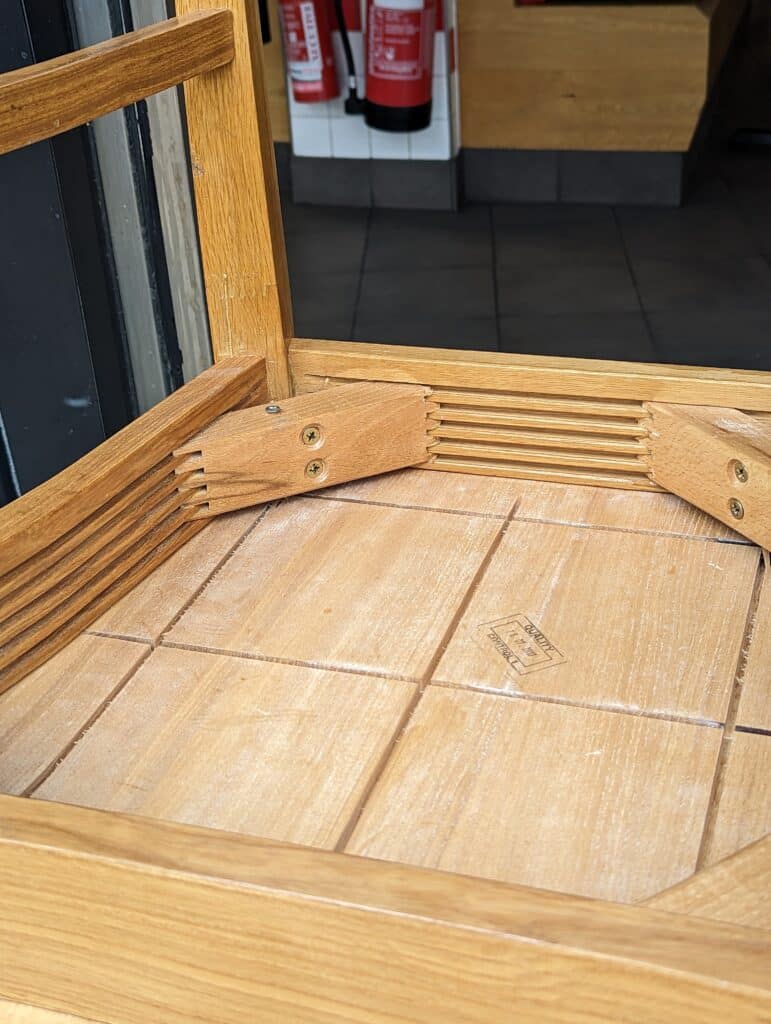
The manufacture and assembly of this solid hardwood chair will be no more than a ten man-minute-involvement in manufacture time if that. The chair shows no physical deterioration and the date stamp clearly shows a six-year span since its manufacture.
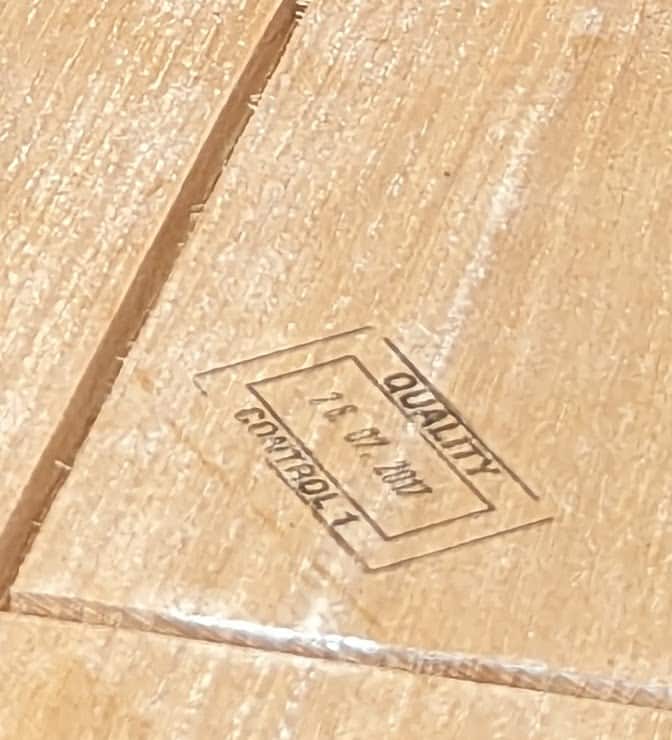
How it Works
It’s a minimalist maximalist securement altogether. Minimalist in that dowels install quickly and impact minimally in presence yet maximalist in the intrinsic speed of manufacture and assembly. Dowels are much less demanding than full mortise and tenon joints in that they take out the minimum amount of wood and, provided the holes are bored with absolute precision, alignments can be spot-on square-on or angled according to need. Rails cut in hundreds and even thousands can be a continuous process over days and weeks and in a month two thousand chairs can be packed ready for assembly elsewhere saving on shipping and warehousing and even assembly processing at the point of manufacture. Two 10mm dowels to the ends of the rails will take out half as much wood from the mortised area which on this width of rail and size of log would have created a real weak spot in the design if left at that. That said, the twin dowels into the ends of the rails would have weakened the rail too. To get around this the designers added the corner bracing to transfer energy away from the joint proximity towards the middle of the rails via the angled fingerjointing. The two screw heads engage with a screw insert in the inner corner of the leg. (These can be inserts or bolts through. I have seen both used consistently.) These inserts have phenomenal strength and resistance but their real value is in pulling the leg and rails into one another which also assists with the speed of manufacture as this mechanical pull eliminates the need for clamping and waiting for glue to dry and cure.
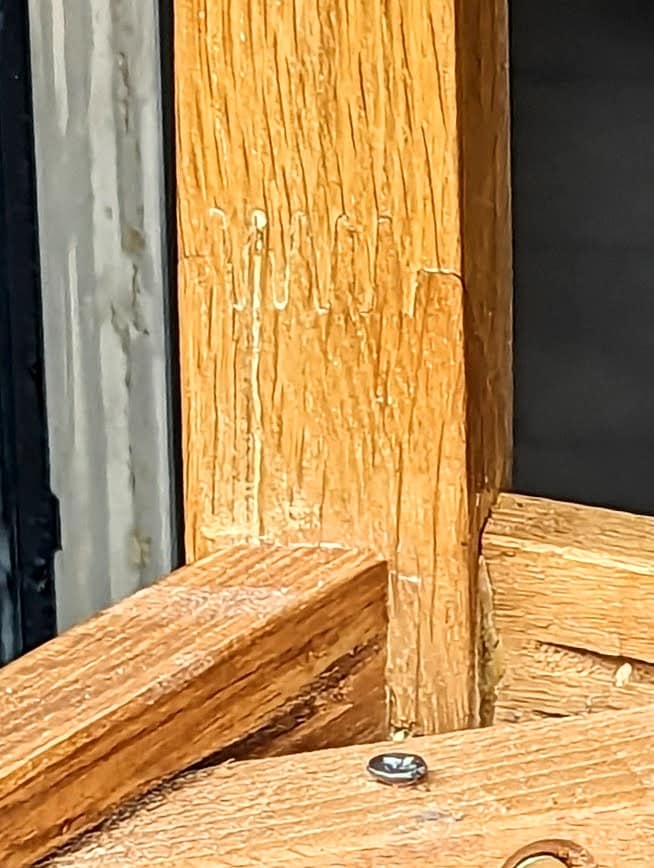
You will barely notice the finger joint on the leg a few inches up (or down if righted) from the joint area. In our solid-wood making we would be very unlikely to scarving any joint in a chair leg for fear of glue failure or lack of continuous grain throughout the leg in this critical area. Any break in a chair leg can be catastrophic for us as makers. Of course, we are constantly;y told that the glue is stronger than the wood. That’s not true in several circumstances but it might be true in long-grain-to-long-grain glueing. I say might because there are several anomalies with this way of looking at it. These finger joints are quite amazing though. Something that we cannot do so well by hand but with a spindle moulder or dedicated machine it takes but seconds to do and it’s always utterly skilless once the cutters are installed. A sliding bed will finger-joint many sections in a single pass, flip every alternate one sideways and along its length and the joint slides in place for an airtight, watertight friction fit even before the glue is applied. At the end of a run, there is zero waste.
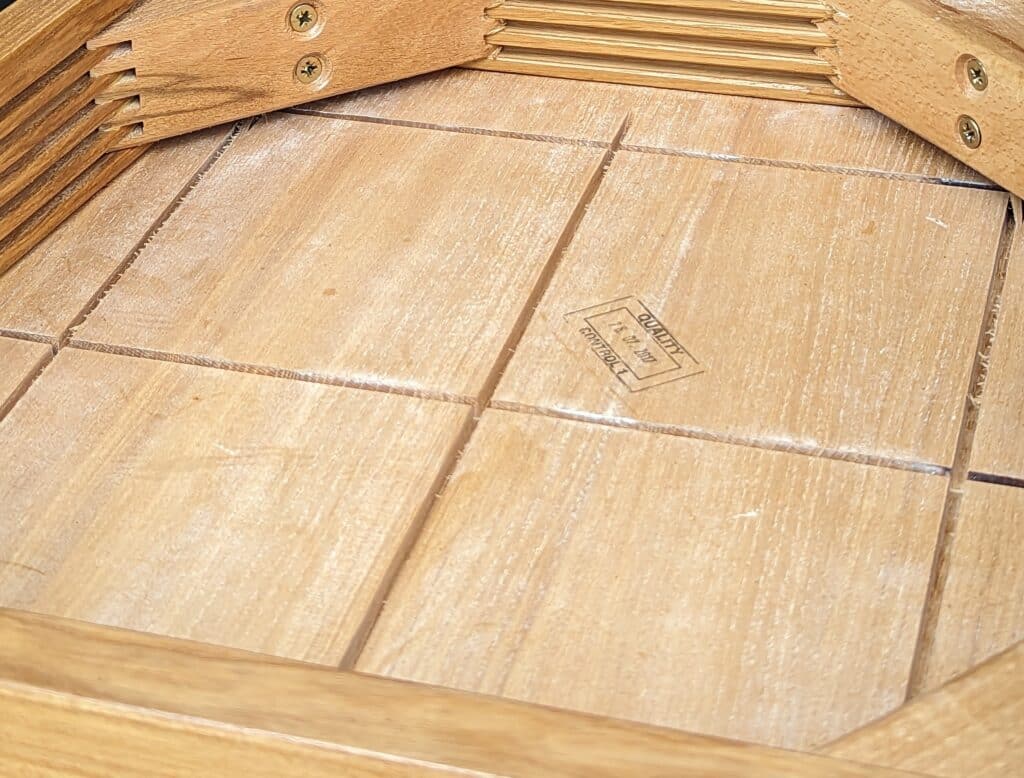
Lastly, the relief cuts in the underside of the solid seat minimise later distortion after manufacture. you retain the appearance of a solid seat above while ensuring the seat stays flat when atmospheric changes occur. See the poorly seated screw in the corner brace, that’s it for securing the seat to the frame. Not greatly done but it works.
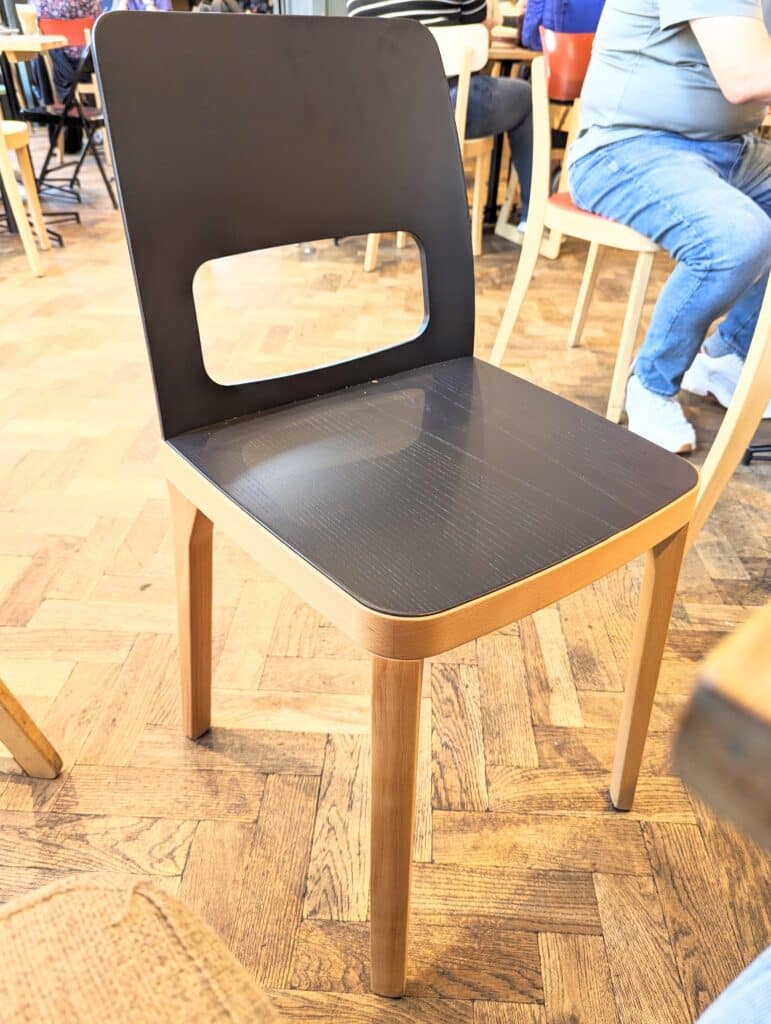
Mass-made chairs are remarkably designed and made. In a domestic home they would be lifetime chairs and the tolerances are remarkable. For most of us, a dining chair might have an hour’s use a day if that. In cafes, they will more likely see eight hours of use seven days a week and will likely go on for many years.
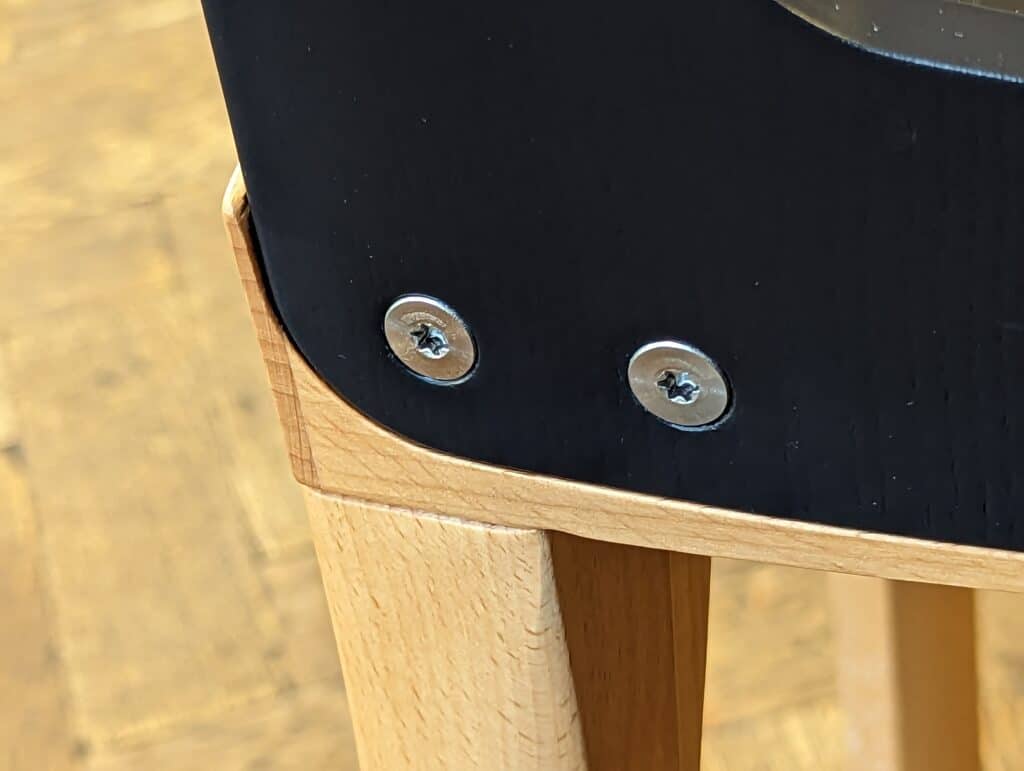


Thanks for this interesting insight into mass produced furniture.
My question would be why groove the entire rail length, could not a stop have been used to groove the end section where needed only?
My guess is that long lengths of machine planned and thicknessed timber are put through an industrial spindle moulder very quickly. These lengths can then be drop-sawed into the short lengths needed for a seat frame. Dozens of chair seats in less than an hour.
If you look closely you will see that the grooves do not go all the way to the ends so they do pass the rails between two stops which is literally a five second pass. Also, these manufacturers do work every detail out for the fastest outcome. I doubt that we sitting in our home armchairs would be able to contribute anything to time and motion experts.
Excellent reply
Paul you are so right, my error in glancing too swiftly, the technique you spoke of was one we commonly practiced at Gordon Russell Furniture Broadway and Swindon, I should have gone to Specsavers.
Probably quicker to groove a 2Mtr length rail in one pass and then cut the rails to size afterwards.
I have explained that that did not happen. Credit where credit is due––the machinist stopped before each end to minimise the risk of weakening those ends where the dowels would be installed. I know we think this or that woukld make sense but in this case the machinist went for integrity. I respect this.Also, the restaurant is a chain of hundreds of restaurants each with at least 60 chairs per unit. It’s a good sized order for a manufacturers to design and make for. That being so, they are not making from two metre lengths.
Another insightful article. I suspect you get some odd looks when you photograph the underbelly of a chair in a public restaurant. I always enjoy your writing.
When people walk down the streets taking selfies and talking to no one apparent and laugh as they go, they don’t pay much attention to me.
Many are so selfish that very little is noticed outside our own limited view. Now that is the truth, Paul
Yet when an elderly gent with no local family becomes ill, my faith in people are restored as we sit with him during his hospital stay. We all learn so much about each other. It is time well spent.
I really enjoy how you explain the principles of modern construction techniques.
While I’ll probably never make a doweled joint at some point I may wish to reinforce a joint with such limitations having been made using more traditional methods.
Not too long ago I installed some base molding in a room I was renovating. The lengths I bought at the big box store were 20 feet long and spliced together using the same scarf joint.
Being painted I really didn’t care but I noticed that the joints would separate if not handled carefully. I don’t even think they were all glued if any were glued at all. Once they were nailed in they never moved at least not yet.
“Lastly, the relief cuts in the underside of the solid seat minimise later distortion after manufacture. you retain the appearance of a solid seat above while ensuring the seat stays flat when atmospheric changes occur”
Sorry, but I didn’t understand it, how can the relief cuts on solid wood minimise distortion…? 🤔
Thanks.
Solid wood over a wider area can tend to distort with every extreme atmospheric exchange of moisture levels and especially over protracted periods when the wood can absorb and release moisture accordingly. This usually causes cupping the deep saw kerf breaks the continuity of grain in bands and allows more ‘stretch’ between sections.
Thanks Paul for the insight. A bit over 20 years ago, a friend (with my feeble assistance) built me a very nice desk from a Fine Woodworking plan. I use the desk daily to this day. It gave me the taste to want to make furniture for myself.
As for the chair for the desk, we decided it would be better if I found one. I looked for six months before I found a chair design that complimented the desk. Bought it unfinished and my friend (with my assistance) did some minor modifications to help it match the desk. I use that chair as well to this day. It held up well. About 4 years ago I made the mistake of leaning back in it and heard a crack. When I repaired it, I noticed the same config as you blogged about. I was never certain how good this configuration was. Glad to hear it sounds like a solid set up. I rarely every lean back on chairs and I regret that I damaged my chair. Fortunately, my repair has made it solid for the past 4 years.
Interesting the myth of end grain gluing being weak continues. Glue two square pieces together, one end grain, one long grain. Keeping them square eliminates the disparity in leverage you get with long pieces of narrow widths. The force needed to break either joint is usually equal, sometimes even greater with end grain joints. Oak has that peculiar porosity that is tubular straw like. A coat of glue, pushed into that end grain, then another coat applied give a micro tenon effect. Pat Sullivan demonstrated this quite well in his video. As you are skeptical due to “the way we’ve been taught and always done it”, try the experiment. I used roughly 3”x3”x1” blocks of red oak, that was a year ago. I offer it to friends to break the joint by hand, using whatever fulcrum they wish, no joint failure to date.
Not interested in pursuing such things. I see how end gran glue gives up more easily in the day to day of life at the bench and then after delivery. Different woods and then wood surfaces within their species are diversely variable and thereby different in glue ups too, end of. Also, I’m not “skeptical” as you say for any reason at all and especially because of what you say I have been informed by. I mostly go back always to my personal experience and not to people experimenting in artificiality.
It is a question of leverage, really. That simple test is designed to work as a test, but it has nothing to do with reality. Try the same thing with a 3x3x20” stick, and make a bridle joint with the same dimensions.
There is a difference in real world applications, and content creation purposes where the “right” question needs to be asked in order for the content to make any sense.
I don’t know how you thought that the “myth of end grain gluing” came into play here. Are you talking about the finger joints, the corner blocks or what? The study that was shown in Fine Woodworking was significant, but only addressed a small part of the overall picture. We all “know” that glue is stronger than wood, but even that is a falsity – glue is stronger than lignin, not cellulose. The reason a glue joint fails sooner on long grain to long grain glue up compared to end-grain to end-grain is because the lignin isn’t involved in the end-grain to and-grain configuration, whereas the lignin fails in the long-grain to long-grain glue-up. Here, the fact that the cellulose is stronger than the lignin is what causes the glue, rather than the wood, to fail.
The (overwhelmingly) main source of strength in the leg/seat side joint is the dowels – any motion other than being pulled out would require tearing the long grain of the hardwood dowels. The glue just keeps the “being pulled out” from happening. As for the finger joints, look at the gluing surface – the fingers provide about 5 times the glue surface. Additionally, the physical placement of the long grain to long grain in the fingers would require that both the glue would slip and the wood would bend in response to a sideways force.
The new knowledge about end-grain gluing is important, just remember that the strength of most of your joints lie in the mechanics of how the parts fit together, and that the glue just keeps the parts there for when the strength is needed. This being said, put glue on your tenon shoulders – it may help out.
That’s an interesting way to brace the corners which I guess also helps prevent any lateral twisting. The method is really good and has reminded me of the Austrian Scythe Snath I’m currently trying to repair for the Earth Trust. The V shaped grooves that prevent the moveable handle from twisting in use have been damaged, so I need to recut or replace them somehow. Not sure yet how to do this, but it’ll be fun finding out.
Mike,
I used a triangular file on mine. They weren’t badly damaged, but running a saw file through kept them true.
Rico
I have used chairs with such a construction in my household with 2 children for over more than 25 years. Solid pine wood was used and the chairs do not show any trace of deteriorating joints. Very effective construction I would say.
Hi Paul, thanks for the post. While the finger-joints (the ones to get longer pieces from short lengths) might have ecological and economical benefit I was surprised that ikea used them for bed slats in one of their designs. My wife wanted one for her room which is used for guests when they come to our house. Around half of the thin slats where finger-jointed the rest was made of fully grown lenghts. Without much use of the bed almost all finger-jointed slats snapped through over two years. I didn’t complain to ikea because it was a quick repair for me with solid (construction grade) pieces with more or less intact long grain and by doing so I could silently re-emphasize my opposition to this (and many more of their) product[s]. My sister liked the bed and bought one for their guest room. The first thing I looked for when I came to visit was the slats and at hers they were all grown lenghts. Obviously unlike me many people had complained about the weak parts and ikea had to adapt their material to make it more sturdy (or to keep selling it).
Very fun post, the industrial design of mass-produced chairs, and the thought that goes into the assembly process, is truly remarkable. The way these corner braces pull and clamp the apron pieces to the legs is very clever.
In my 20s I spent some time working in a furniture factory, mostly cabinetry. The company made a range of furniture styles and a variety of quality (ranging from veneered MDF to single boards), It was all rabbets+dowels, and they had hydraulic clamping machines that could pull together large workpieces with no effort. My impression was that the dowels were often used more for alignment than strength. With a little practice, we learned how to apply just the right amount of glue to avoid squeeze-out and keep it clean. If the pieces were misaligned going into the clamping machine, the boards would come flying out and so one learned to do it right as a matter of self-preservation.
It wasn’t a job I wanted to do for a long time, however, it was still a valuable experience to see how these processes can be engineered for maximum efficiency.